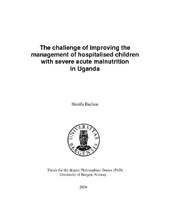| dc.rights.license | The work can be used, that is be referred to, linked to, cited from, printed and downloaded, within the frames of Act No. 2 of 12 May 1961 Relating to copyright in literary, scientific and artistic works, etc., with subsequent amendments. | |
| dc.contributor.author | Bachou, Hanifa | en_US |
| dc.date.accessioned | 2008-12-08T12:50:42Z | |
| dc.date.available | 2008-12-08T12:50:42Z | |
| dc.date.issued | 2008-06-03 | eng |
| dc.identifier.isbn | 978-82-308-0579-4 (print version) | en_US |
| dc.identifier.uri | https://hdl.handle.net/1956/3062 | |
| dc.description.abstract | Millennium Development Goal (MDG) number 4 is to reduce the global mortality rate among under-fives by two thirds between 1990 and 2015. Efforts to prevent child deaths need to be stepped up in order to meet this target. World-wide, hospital case fatalities of severe acute malnutrition remain high. Objectives: This study was designed to establish key factors contributing to the high case fatality rate among children with severe acute malnutrition admitted to Mulago Hospital, Uganda, to improve on these factors and to document the effect on case fatality. Methods: A ‘before’ and ‘after’ design was used. A total of 450 children below the age of 60 months, with weight for height below -3 z-scores of the median NCHS reference or with oedema, were consecutively enrolled between September and December in 2003 and 2004 (220 pre- and 230 post-period, respectively). In both periods, we collected the following on admission to the hospital: socio-demographic data; blood for biochemical, haematological, blood culture and sensitivity and HIV-1 serology (ELISA/PCR) tests; urine for microscopy, culture and sensitivity; and a chest X-ray of each child enrolled. The child was then followed until discharge or death. We analysed the data, identified factors significantly associated with mortality and launched an improved practice. Results: The results in the pre-period indicated that deaths within the first week of admission were significantly associated with inappropriate use of blood transfusions and IV fluids in the management of severe acute malnutrition. Promoting the appropriate use of blood transfusion and fluids in accordance with WHO recommendations resulted in: first, a significant reduction in inappropriate use of blood transfusions and IV infusions; second, a significant reduction in deaths associated with blood transfusion or IV fluid infusion during the first week from 82% (31/38) to 23% (8/35); third, a reduction of mortality during the first week from 70% to 61%. However, the overall case fatality rate was not reduced (24%, 24.8%). We also found that the children in the post period were more ill than those in the pre-period. The common co-morbidities were HIV infection, blood stream infections (septicaemia), diarrhoea and respiratory tract infections. These were more frequent in the post-period than in the pre-period, though we found no significant association with mortality. Conclusions: These studies have shown that in Mulago Hospital, inappropriate management - outside that recommended for management of severe acute malnutrition - contributes to mortality. Partial implementation of WHO-recommended standardised care, as in this study, did not improve the overall case fatality rate. A holistic health system approach linked to improved resource allocation for paediatric clinical care is imperative in order to attain Millennium Development Goal number 4. | en_US |
| dc.language.iso | eng | eng |
| dc.publisher | The University of Bergen | eng |
| dc.relation.haspart | Paper I: BMC Pediatrics 6(7), Bachou, Hanifa; Tumwine, James K.; Mwadime, Robert, K. N.; Tylleskär, Thorkild, Risk factors in hospital deaths in severely malnourished children in Kampala, Uganda. Copyright 2006 Bachou et al; licensee BioMed Central Ltd. The published version is available at: <a href="http://dx.doi.org/10.1186/1471-2431-6-7" target="blank"> http://dx.doi.org/10.1186/1471-2431-6-7</a> | en_US |
| dc.relation.haspart | Paper II: Annals of Tropical Paediatrics 28, Bachou, Hanifa; Tumwine, James K.; Mwadime, Robert K. N.; Tahmeed, Ahmad; Tylleskär, Thorkild, Reduction of unnecessary transfusion and intravenous fluids in severely malnourished children is not enough to reduce mortality, pp. 23-33. Copyright 2008 The Liverpool School of Tropical Medicine. The published version is available at: <a href="http://dx.doi.org/10.1179/146532808X270644" target="blank">http://dx.doi.org/10.1179/146532808X270644</a> | en_US |
| dc.relation.haspart | Paper III: Nutrition Journal 5(27), Bachou, Hanifa; Tylleskär, Thorkild; Downing, Robert; Tumwine, James K.; Severe malnutrition with and without HIV-1 infection in hospitalised children in Kampala, Uganda: differences in clinical features, haematological findings and CD4+ cell counts. Copyright 2006 Bachou et al; licensee BioMed Central Ltd. The published version is available at: <a href="http://dx.doi.org/10.1186/1475-2891-5-27" target="blank">http://dx.doi.org/10.1186/1475-2891-5-27</a> | en_US |
| dc.relation.haspart | Paper IV: BMC Infectious Diseases 6(160), Bachou, Hanifa; Tylleskär, Thorkild; Kaddu-Mulindwa, Herbert D.; Tumwine, James K., Bacteraemia among severely malnourished children infected and uninfected with the human immunodeficiency virus-1 in Kampala, Uganda. Copyright 2006 Bachou et al; licensee BioMed Central Ltd. The published version is available at: <a href="http://dx.doi.org/10.1186/1471-2334-6-160" target="blank">http://dx.doi.org/10.1186/1471-2334-6-160</a> | en_US |
| dc.title | The challenge of improving the management of hospitalised children with severe acute malnutrition in Uganda | en_US |
| dc.type | Doctoral thesis | |
| dc.subject.nsi | VDP::Medisinske Fag: 700::Helsefag: 800 | nob |
